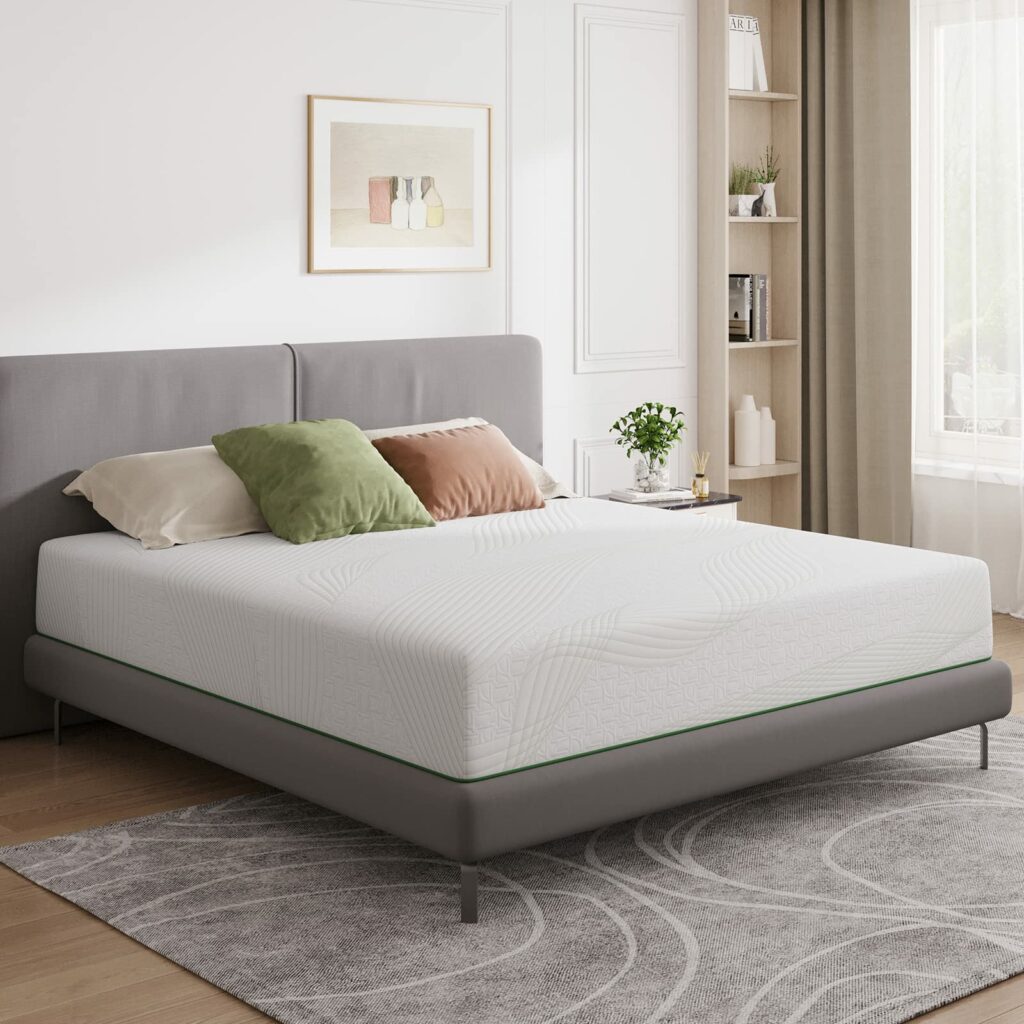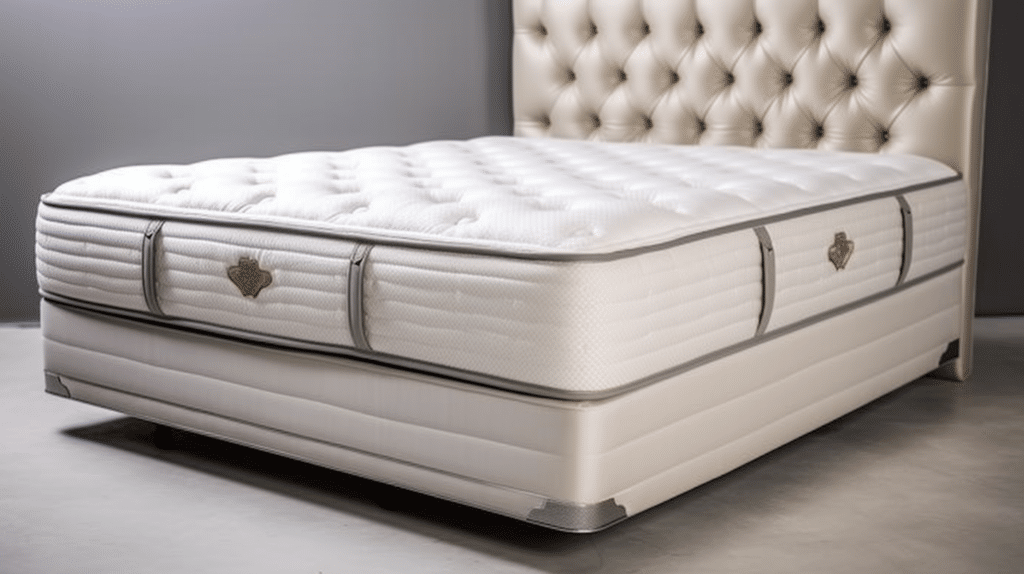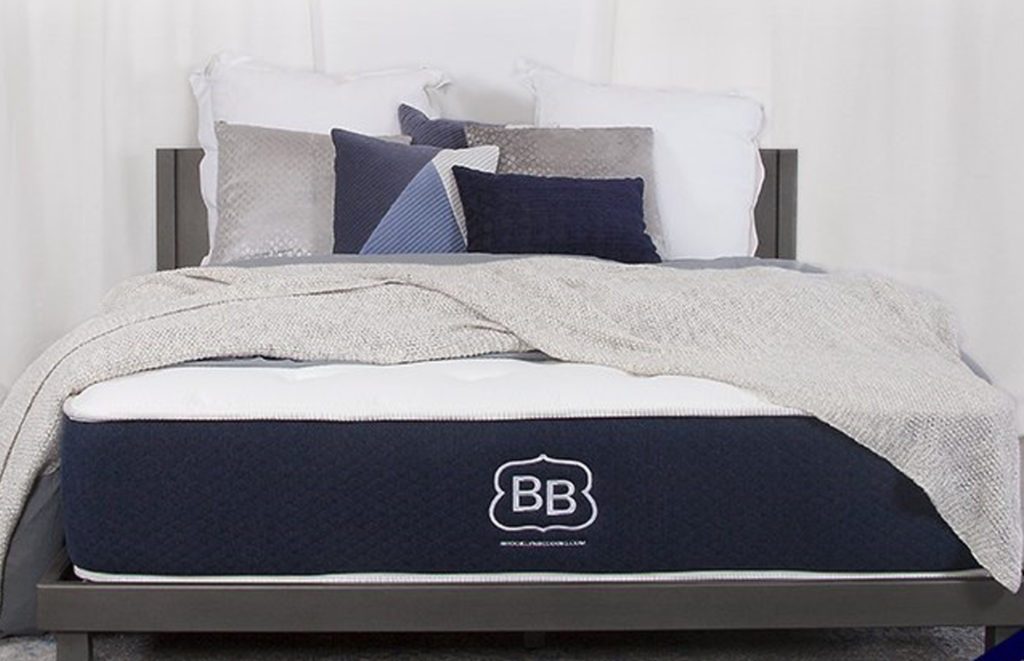Our editors independently researched the best products online to produce this list. We may receive commission on purchases made from the links below but this will never affect our product choices. Click here to read our disclosure.
Choosing the right mattress is crucial for individuals suffering from sciatica. The National Institute of Neurological Disorders and Stroke reports that over 3 million people in the US are affected by sciatica each year. Finding the best mattress for sciatica can significantly reduce or eliminate the associated pain.
In this informative article, we will explore the key considerations for selecting a mattress that provides the necessary support and comfort for individuals with sciatica, allowing them to experience quality sleep and relief from symptoms. When selecting a mattress for back pain, including sciatica, various factors should be taken into account, such as firmness level, design features, cost, and more.
We will thoroughly examine these factors to ensure you can make an informed decision when shopping for your new mattress. Furthermore, we will discuss the importance of having the correct type of bed for individuals with sciatica. By following our guidance on selecting the ideal mattress, you will be able to find a bed that effectively alleviates your discomfort while promoting restful nights of sleep.
To aid your search, we have extensively researched the top online mattress retailers to identify the best options for individuals experiencing sciatic nerve pain. Recognizing that no single mattress suits everyone, we have also compiled reviews of seven mattresses to help you determine which one is likely to suit you best.
- Layla Mattress – (Editor’s Pick)
- Nest Bedding Alexander – (Best Cooling)
- Nectar – (Excellent Build)
- Purple – Best For Back Sleepers)
- WinkBed – (Best Hybrid)
- Loom & Leaf – (Premium Option)
- Casper – (Best For Side Sleepers)
How We Compared The Mattresses
In our comparison of mattresses best suited for sciatica, the primary focus was on support and pressure relief. A good mattress for sciatica should be able to maintain proper spinal alignment and relieve pressure points, particularly in the lower back and hips. We evaluated the construction of each mattress, including the type and density of materials used and the mattress type itself, whether memory foam, latex, innerspring, or hybrid.
Firmness was another important aspect of our analysis. While the ideal firmness level can depend on factors like body weight and preferred sleeping position, a medium-firm mattress is often recommended for people with sciatica as it provides a balance of support and comfort. However, we considered mattresses across the firmness spectrum to accommodate individual preferences.
We also evaluated each mattress’s ability to provide targeted support and contouring. Mattresses with zoned support systems or those with memory foam layers can provide extra cushioning to sensitive areas, which is crucial in reducing sciatica symptoms.
Additional factors such as the mattress’s durability, how well it isolates motion, and its edge support were considered. Strong edge support can make getting in and out of bed easier, which can be important for those with sciatica.
Customer reviews and feedback, especially from people who have sciatica, were incorporated into our analysis to get a sense of real-world experiences with each mattress. Lastly, we considered the warranty and sleep trial policies of each mattress, ensuring that customers would be making a secure and valuable purchase. This comprehensive evaluation allowed us to identify the best mattresses suitable for alleviating sciatica symptoms.
Comparing Essential Criteria
| Mattress | Firmness Level | Support & Spinal Alignment | Pressure Relief | Special Features |
|---|---|---|---|---|
| Nest Bedding Alexander | Medium, Luxury Firm, Plush | Zoned support coils, TitanChil Endurance Foam | Gel-infused memory foam | Multiple firmness options |
| Nectar | Medium-firm | High-density memory foam | High-density memory foam | Adaptive foam layers |
| Purple | Medium-firm | Hyper-Elastic Polymer grid | Hyper-Elastic Polymer grid | Unique grid structure for pressure relief |
| WinkBed | Soft, Luxury Firm, Firm, Plus | Zoned support coils, high-density foam | Gel-infused memory foam | Hybrid design, multiple firmness options |
| Loom & Leaf | Relaxed Firm, Firm | High-density memory foam | High-density memory foam | Premium memory foam |
| Casper | Medium | Zoned support foam | Memory foam, polyfoam | Zoned support for targeted pressure relief |
Mattress For Sciatica Sufferers Reviewed
Layla Mattress
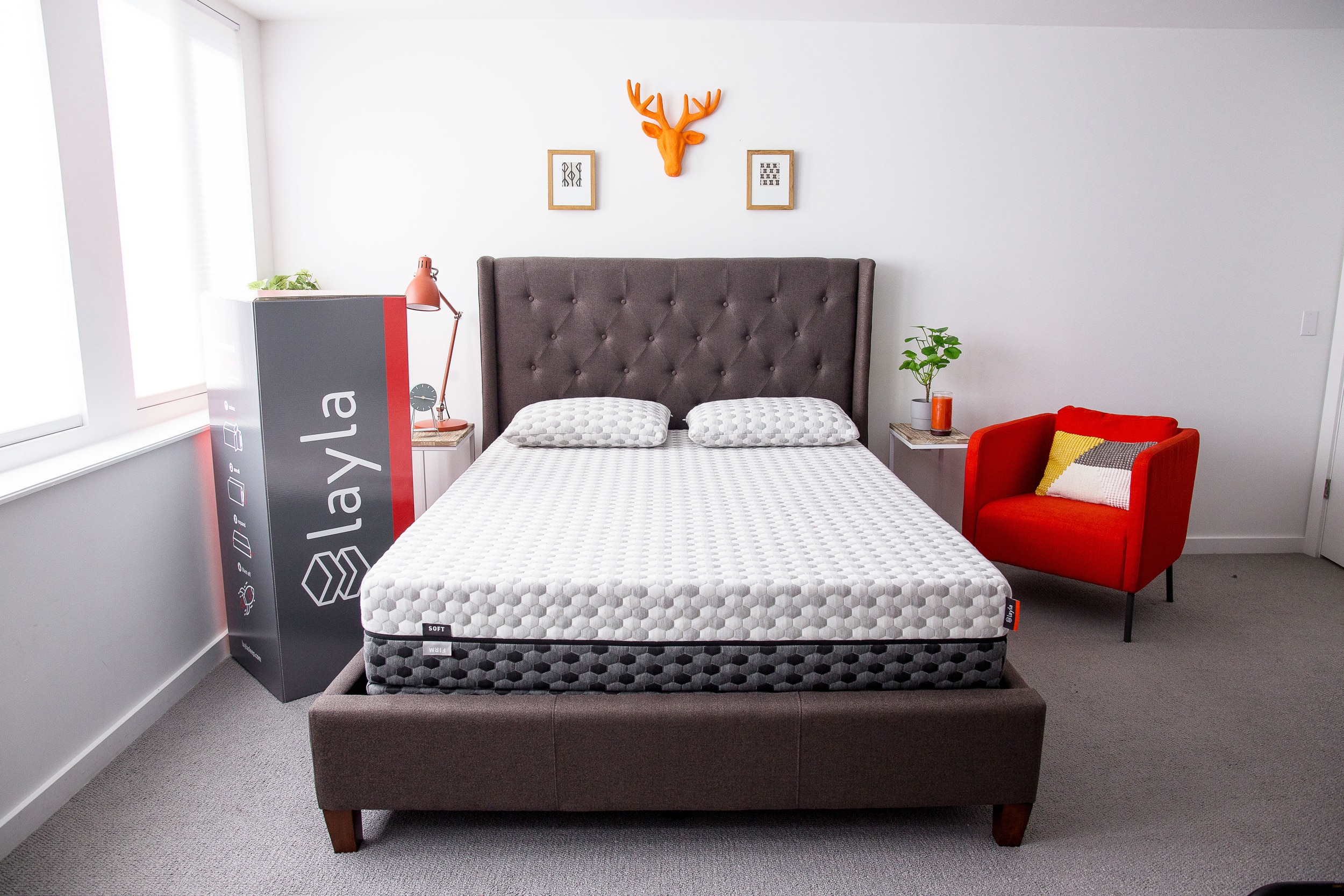
As a mattress expert, I had the pleasure of trying the Layla mattress, and I must say, it’s truly a fantastic option for sciatica sufferers. With a budget-friendly price tag under $1000, this mattress offers not only exceptional value for money but also a versatile design and a high level of comfort that is hard to beat.
What sets the Layla mattress apart is its innovative double-sided design, offering two distinct firmness options in one mattress. This feature is especially beneficial for those who sleep in various positions or are unsure about their ideal firmness level for reducing sciatic pain symptoms. With Layla’s generous 120-night trial period, you have ample time to test both sides and find the perfect balance of support and comfort for your needs.
On the softer side, there’s a 3-inch layer of memory foam with a firmness rating of 4.5 out of 10. If you’ve previously found memory foam mattresses too hard, this side might just be your ideal match. However, if you’re a back sleeper or someone with a heavier build, flipping the mattress to the firmer side brings you closer to the central support layer, resulting in a 7 out of 10 firmness rating. But do keep in mind that if you prefer an extremely firm mattress, you might still find this side a tad soft.
One of my favorite features of the Layla mattress is the cooling gel-infused cover and top layers of foam on both sides. The copper-infused gel effectively conducts heat away from your body, making it a cooler alternative to other memory foam mattresses – a fantastic choice for hot sleepers or those living in warmer climates.
Restless sleepers, I’ve got good news for you as well! The Layla mattress has a 4.5-inch support foam layer at its core, which does an excellent job of reducing bounce and motion transfer between partners. No more rolling into the middle or waking up from your partner’s movements!
Lastly, Layla offers a lifetime warranty for manufacturing defects and significant sagging or loss of shape. That’s a testament to the confidence they have in their product’s quality and durability.
In conclusion, as someone who has tried the Layla mattress, I can confidently recommend it as an outstanding option for sciatica sufferers. With its versatile design, superior comfort, and cooling properties, it’s a fantastic investment for your sleep health.
Further Reading: Check our full Layla mattress review.
- Double-sided design gives you the option of testing different support levels
- Copper infusion gives a cool night’s sleep
- Good motion isolation
- Great value
- Lifetime warranty
- Heavy to flip over (especially for one person)
- Not as firm as other mattresses
Nest Bedding Alexander Signature Flippable
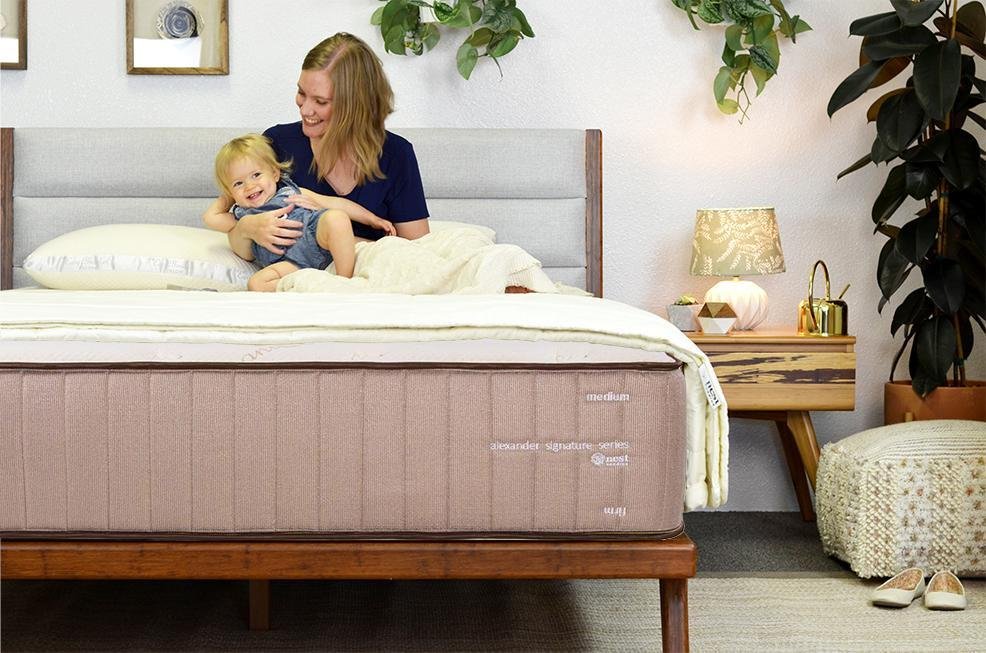
The Nest Bedding Alexander Signature Flippable is another fantastic option for those suffering from sciatica. This mattress also boasts a double-sided design, with a medium side tailored for back and side sleepers, and a firm side aimed at back and stomach sleepers.
Finding the most comfortable sleeping position for sciatica can be a bit of trial and error, but the Alexander Signature mattress offers a standard 100-night trial, allowing you to spend a few weeks experimenting with both sides to find the one that suits you best.
One of the standout features of this mattress is the CoolFlow quilting foam that tops both sides, designed to keep you cool while you sleep. However, some reviewers have mentioned that the mattress can still get quite warm – particularly on the firm side, which lacks the additional copper-infused gel foam layer. Whether this is an issue or not will depend on your individual sleeping temperature preferences and how much control you have over your bedroom environment.
It’s worth noting that a few users have found the edges and corners of the mattress to be somewhat squishy. While this is a common concern with memory foam mattresses, it might be something to consider if you tend to sleep near the edge of your bed.
Comparing the Nest Bedding Alexander Signature Flippable to the Layla mattress, there are a few key differences. Both offer double-sided designs, but the Layla mattress has a more budget-friendly price point and a slightly longer trial period of 120 nights. Additionally, the Layla mattress seems to perform better in terms of temperature regulation, thanks to its copper-infused cooling gel on both sides. However, the Alexander Signature mattress excels in terms of material quality and offers a lifetime comfort guarantee, which demonstrates the confidence they have in their product.
Unlike many of the mattresses reviewed here, which are primarily available online, Nest Bedding has a series of showrooms across the United States where you can test their beds in person. If you prefer to shop online, you can often find great deals with Nest Bedding coupons, significantly reducing the cost of a new sciatica-friendly mattress.
One aspect that truly sets the Alexander Signature Flippable mattress apart from its competitors is the high-quality materials used. Nest Bedding mattresses are made in the USA, and all their foams are CertiPUR-US certified, meeting low VOC emission standards – which is great for indoor air quality. Furthermore, they offer a lifetime comfort guarantee, and their customer service is top-notch.
In summary, having experienced the Nest Bedding Alexander Signature Flippable mattress, I can wholeheartedly recommend it as a superb option for sciatica sufferers. With its versatile design, quality materials, and excellent customer support, it’s a solid investment for improving your sleep quality. When compared to the Layla mattress, your choice will ultimately depend on factors such as budget, temperature preferences, and material quality priorities. Both mattresses are excellent options, each with their own unique strengths.
- Two-sided design gives medium and firm options
- High-quality materials
- Excellent customer service
- Made in the USA
- Lifetime comfort guarantee
- Some people find it a little warm
- Edge support isn’t great
Nectar
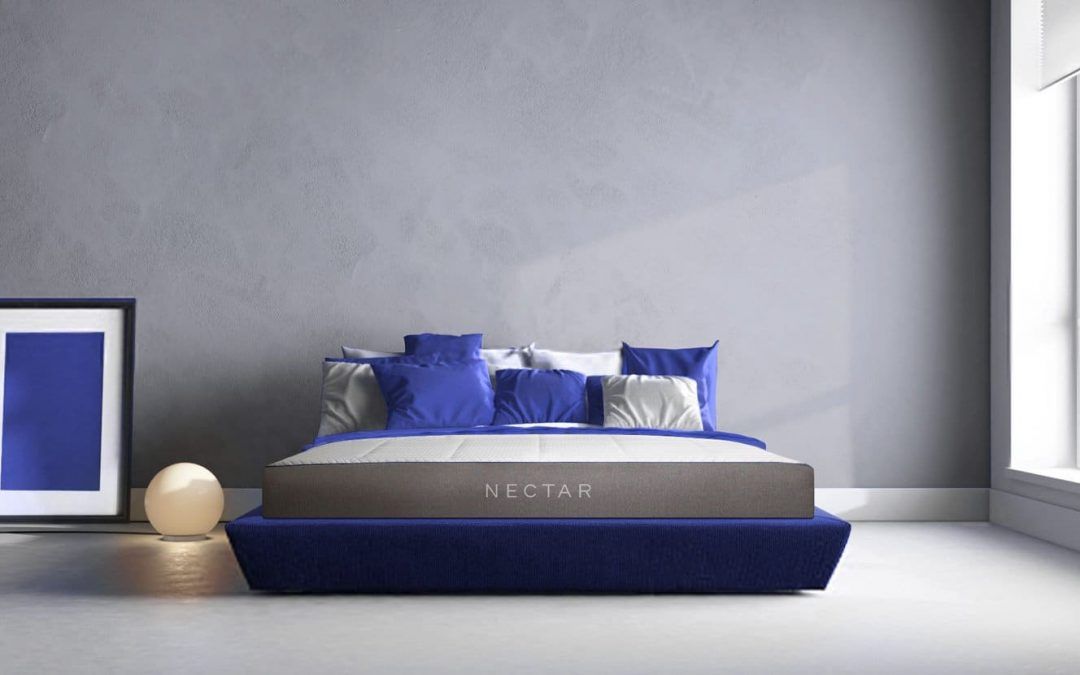
If you’re uncertain about whether a foam mattress is the right fit for you or hesitant to spend thousands of dollars, then the Nectar mattress might be the perfect choice for you.
One thing I absolutely loved about the Nectar mattress was its incredible 365-day trial period. Being able to sleep on it risk-free for an entire year, which is three times longer than the industry standard, gave me so much peace of mind. I found this extended trial especially helpful as it allowed me to test the mattress during different seasons before making a final decision. If you, like me, experience intermittent sciatic pain or are affected by specific triggers, having a longer trial period could be a game-changer.
The Nectar mattress comes with a “forever” warranty, which made me feel secure in my investment. It covers the construction, materials, and durability for as long as you own it. I also loved that it’s compatible with all types of bed frames, so there was no need to invest in a new bed. Plus, it’s quite budget-friendly – the most affordable among the mattresses I’ve reviewed.
In terms of quality, I was pleasantly surprised by the Nectar mattress. It consists of three distinct memory foam layers nestled between a firm, breathable base layer and a cooling cover. It offers a medium-firm level of support, which I found suitable for all types of sleepers. If you’re someone who prefers a soft mattress, you might need some time to adjust, but remember that firmer mattresses are generally better for most sciatica patients. If you’re still having trouble sleeping, consider adding a soft mattress topper like I did. It turned out to be more cost-effective than exchanging it for a higher-priced mattress.
The quilted top layer of memory foam is designed to wick heat away from your body. While it may not be as effective at cooling as some other brands, I found that it kept me comfortable throughout the night. The foam also meets CertiPUR-US® quality standards, ensuring it’s free from harmful substances like ozone depleters, PBDEs, TDCPP, mercury, or lead.
One thing to note is that Nectar previously experienced some shipping issues. However, these seem to have been resolved. If you’re in a hurry for a new mattress and customer service is a top priority for you, you might want to explore other options. Personally, I found the Nectar mattress to be a fantastic choice for sciatica sufferers, offering an impressive balance of comfort, support, and value.
- 365-day trial period
- Very affordable
- Medium-firm mattress will suit most sleepers
- CertiPUR-US® certified
- “Forever” warranty
- Some users report shipping and customer service issues
- Slightly soft at the edges
The New Purple
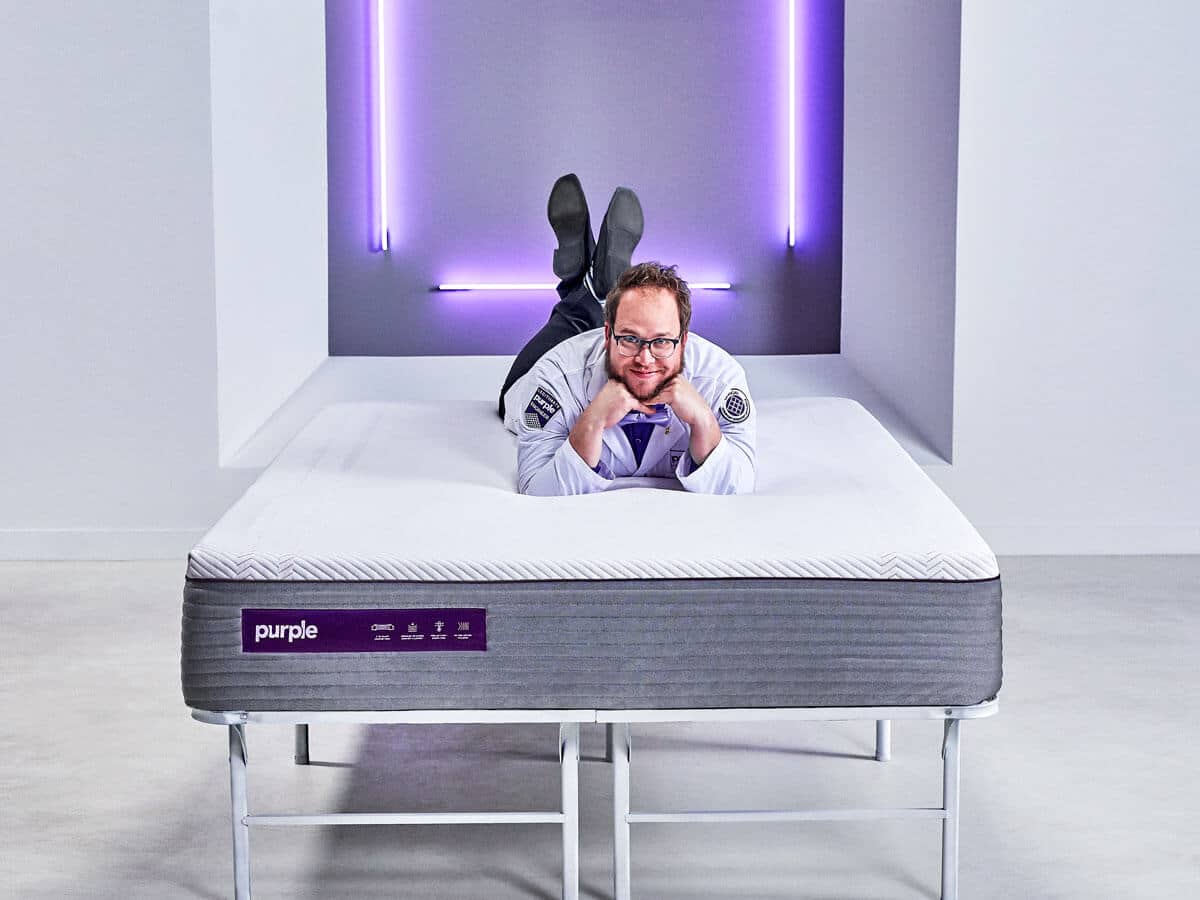
I was excited to recently test out the innovative Purple mattress. Memory foam has been around for decades, so it’s refreshing to see new technology like Purple’s Hyper-Elastic Polymer™ stepping up to address common complaints about memory foam – such as heat retention and deformation over time – while still providing a great night’s sleep.
The hybrid mattress consists of two main parts: a layer of responsive support coils topped with the patented Purple Smart Comfort Grid™. This grid, made from Purple’s Hyper-Elastic Polymer™, comes in three different thicknesses (2, 4, and 6 inches), with the thinner polymer layer providing a firmer feel. I found the elastic polymer to dynamically flex under pressure, providing relief at my shoulders and hips (where side sleepers often feel discomfort) while supporting my lower back and legs. This adaptability makes it suitable for sleepers of all shapes, sizes, and sleeping positions. I must say, the Purple mattress is incredibly comfortable, especially for those suffering from back or other chronic pain.
When comparing the Purple mattress to the Nectar mattress, one of the key differences is the cooling capability. Even with the best memory foam mattresses, hot sleepers like myself might still find themselves overheating. However, the grid structure of the Purple mattress’s upper layer allows for better airflow, and the material itself is temperature neutral, providing even the hottest sleepers with a comfortable night’s rest.
Another difference is the motion isolation. The Purple mattress’s elastic structure does an excellent job of isolating movement, so you can move around without disturbing your partner.
One thing to consider is the weight of the Purple mattress, which comes in at 110 lbs. As someone who suffers from sciatica, I wouldn’t want to lug it around by myself. Thankfully, the New Purple includes complimentary delivery and setup, sparing me from any heavy lifting.
The downside? The cutting-edge technology comes at a price. While the New Purple isn’t the most expensive mattress available, it’s certainly not a budget buy. Since the company is fairly new, its technology hasn’t had years of real-world testing, but it does offer a 10-year warranty.
Overall, I found both the Nectar and Purple mattresses to be great options for sciatica sufferers. The Nectar mattress provides a budget-friendly choice with a longer trial period, while the Purple mattress offers innovative technology and superior cooling capabilities. Ultimately, it comes down to personal preference and budget constraints.
Further reading: Also check our other Purple mattress reviews.
- One of the best mattresses for back and shoulder pain relief
- Excellent cooling effect
- Different firmness options
- Good motion isolation
- Complimentary delivery and in-home setup
- Pricey
WinkBeds
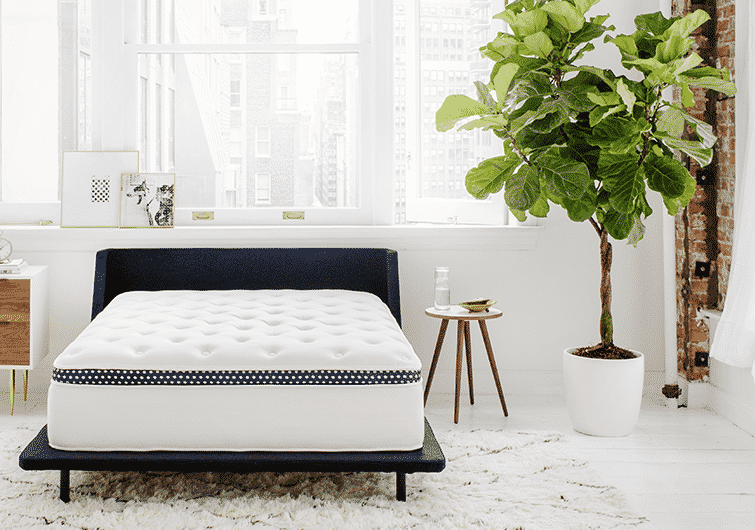
Hybrid mattresses offer a unique experience, combining the feel of a traditional innerspring mattress with the contoured support of foam. And the WinkBeds luxury hybrid mattress is no exception.
What I loved about the WinkBed was the zoned springs in the main part of the base, providing different levels of support based on the pressure your body places on the mattress – which is great news for side sleepers like me. Proper lumbar support can significantly help reduce sciatic pain, and the WinkBeds mattress offers extra support in that area, preventing your spine from sagging.
On top of the base layer, there’s a second layer of micro air-springs designed to improve breathability, followed by a cushioning Euro-pillowtop foam layer. This design gives extra support around the edges of the mattress, making it nearly impossible to roll out of the bed.
When I tried the WinkBed, I appreciated the four different firmness options, including one specifically designed for heavier people. Their most popular model, the Luxury Firm, is a medium-firm mattress that suits most sleepers.
As someone who tends to sleep hot, I found that innerspring mattresses like the WinkBed tend to be cooler to sleep on than memory foam. The foam layer on top is designed to pull heat away from your body, and the micro-springs below help air to circulate, keeping me cool all night.
Another aspect I appreciated about WinkBed was its eco-credentials. Made in the USA using recycled steel and Tencel from FSC-certified forests, it also features CertiPUR-US® accredited foam.
Of course, a high-quality, American-made mattress doesn’t come cheap. However, you might be willing to pay a bit extra for a mattress that lasts for years. The WinkBed mattress has been tested for durability, showing a less than 2% sag rate over a simulated 20 years of sleeping. Plus, if you decide to trade in your mattress for a new model in the future, you can buy a new WinkBed mattress at a 50% discount.
One thing to note is that although the WinkBeds hybrid mattress comes with a decent 120-night trial period, you can’t return it in the first 30 days. While it does take a few weeks to get used to a new bed, if you find you’ve chosen the wrong model from the outset, this could cause some short-term discomfort.
Further reading: For more details on this pressure-relieving mattress check the full WinkBed review.
- Traditional innerspring feel
- Enhanced edge support
- Proven durability
- Handmade in the USA
- Lifetime replacement warranty
- You have to sleep on it for 30 days before returning it.
- Pricey
Loom & Leaf
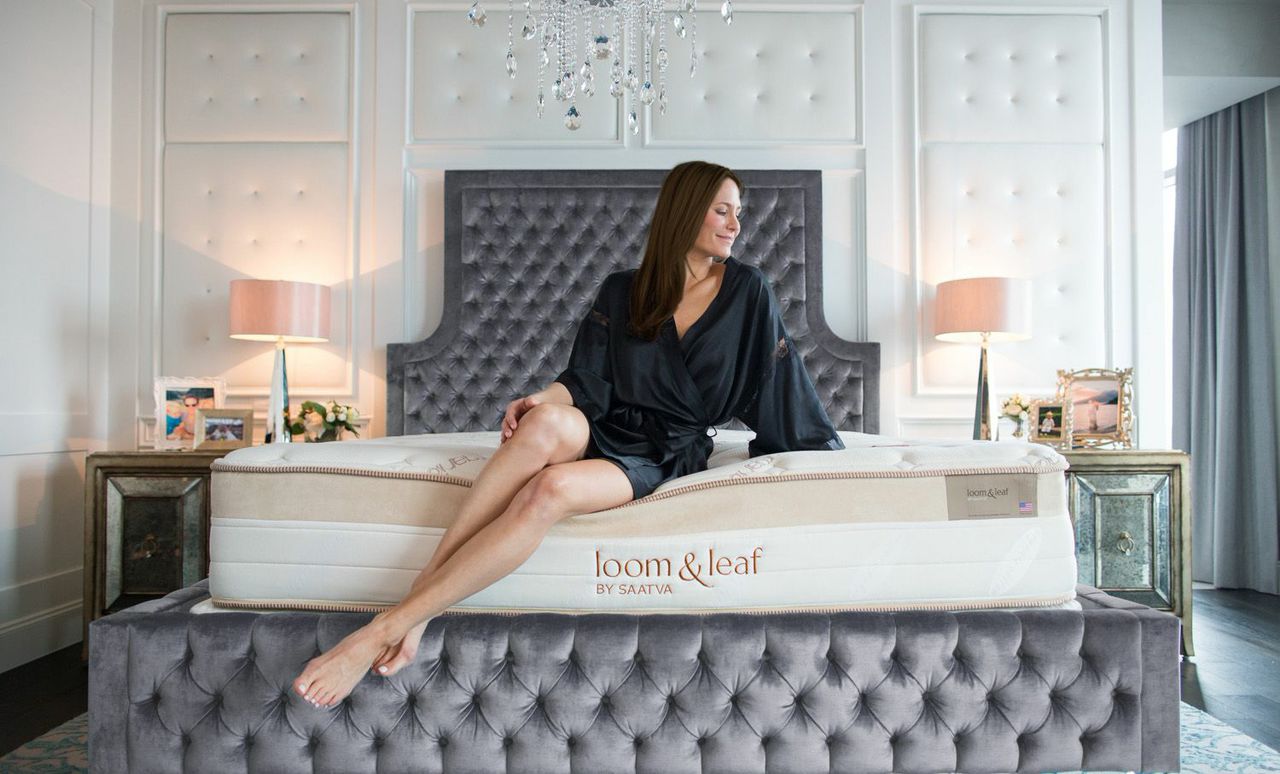
Dealing with sciatica can be challenging, and I know how crucial it is to have a mattress that offers both support and comfort. The Loom & Leaf mattress caught my attention due to its luxurious feel, high-quality natural materials, and excellent spinal support, all while being reasonably priced.
The Loom & Leaf mattress has a 5 lb visco-elastic memory foam layer that hugs the body and provides support. It also has a high-density foam layer for a sturdy base, with a top memory foam layer and organic cotton knit top for added comfort.
Loom & Leaf offers two comfort levels to choose from: “relaxed firm” and “firm.” I found that the firm option might be more suitable for alleviating sciatic pain, but if you’re a lighter person who sleeps on their side, it could feel too firm.
One thing I appreciated about the mattress is how well it absorbs movement, which is great if you tend to move around during the night. However, it does sink a bit at the edges, like most memory foam mattresses.
A concern I had when considering a memory foam mattress was overheating, but Loom & Leaf’s cooling technologies eased my worries. The top layer of memory foam enhances air circulation, and the cooling gel layer adds extra relief, especially for the lumbar region.
The Loom & Leaf doesn’t come compressed in a box like other foam mattresses, but the delivery and installation are included, which is a nice perk.
Comparing the Loom & Leaf to the Layla and Nectar mattresses, I noticed that while the Loom & Leaf feels more luxurious and has advanced cooling technologies, the Layla offers a flippable design with two firmness options, and the Nectar is more budget-friendly with a longer trial period.
In the end, choosing between the Loom & Leaf, Layla, and Nectar mattresses comes down to personal preferences, budget, and how each mattress addresses your sciatica concerns. Each one has unique features, and you may need to prioritize factors like cooling technologies, firmness options, and price to find the perfect match for your needs.
Further reading: Read our full-length Loom & Leaf review.
- High-quality materials with a luxury feel
- Great option for hot sleepers who want a memory foam mattress
- Eco-friendly materials
- Free white-glove delivery and mattress removal
- Made in the USA
- Weak edge support
Casper Mattress
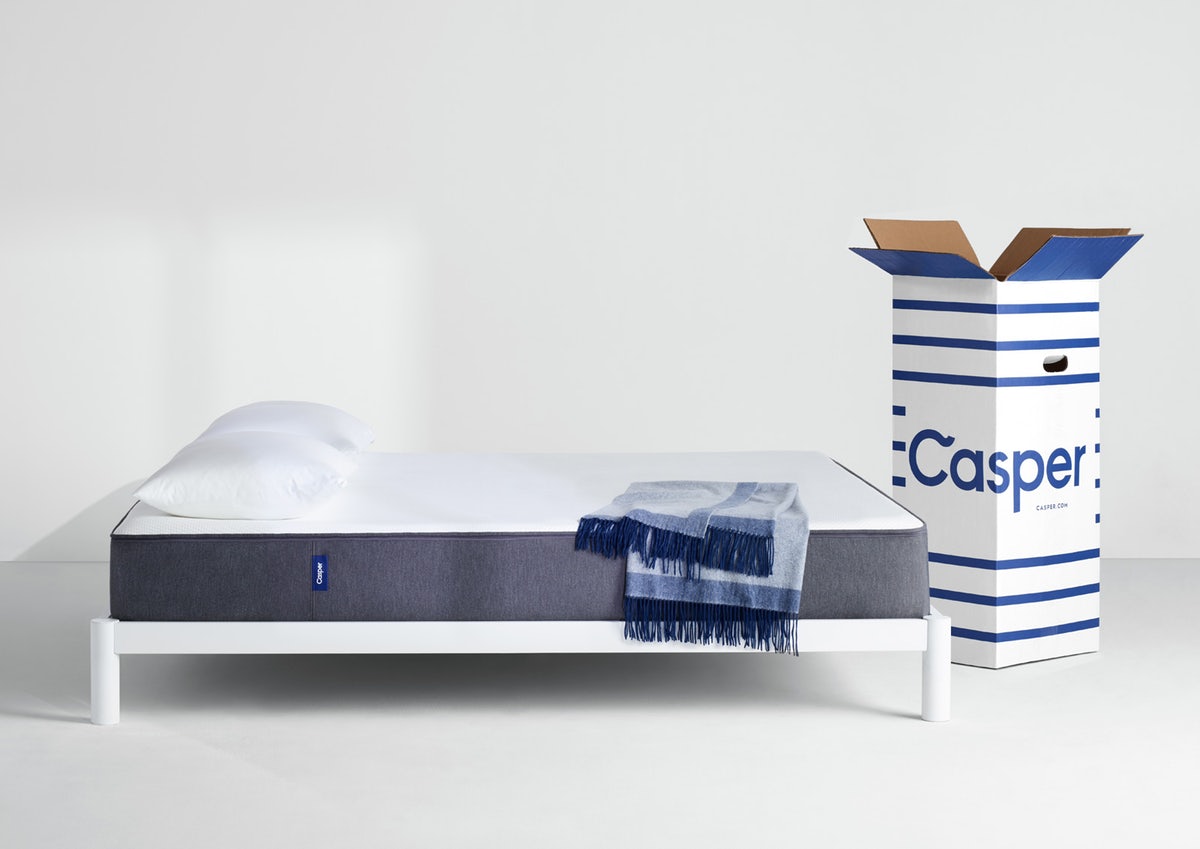
Finding the right mattress when dealing with sciatica can feel like a daunting task. When I discovered the Casper mattress and its zoned support system, I felt a glimmer of hope. The design, which has firmer foam under the hips and core and softer foam at the top and bottom, seemed like it could be a game-changer for my spinal alignment and help ease my sciatica pain.
The Casper mattress not only caters to side sleepers like me but also works well for back and front sleepers who struggle with sciatica. I love that it accommodates different sleeping styles, which is great if you or your partner tend to switch positions throughout the night.
Though I’ve found it comfortable, if you’re heavier than average and prefer sleeping on your back, the Casper might feel too soft for you. In that case, a firmer mattress could provide better relief for your sciatica.
One thing I truly appreciate about the Casper is its open-cell foam construction. It helps prevent overheating, which I’ve experienced with other memory foam mattresses. The thin, breathable top layer allows for better heat circulation, ensuring a cooler sleep experience – something that can be quite helpful when dealing with sciatic pain.
The Casper’s ability to minimize motion transfer has been a lifesaver for me, especially on those nights when my partner tosses and turns. This mattress has helped make my restless nights much more bearable.
When the Casper mattress arrived, I was impressed with its sturdy, 12-inch, four-layer design. With a 10-year warranty and a 100-night risk-free sleep trial, I felt confident in giving it a shot. There was a slight smell when I first unpacked it, but after letting it air out for a day or two, the odor dissipated.
To sum it up, the Casper mattress has been a great blend of support and comfort that has helped me manage my sciatica. Its motion isolation features have also contributed to more restful nights for both me and my partner, even though I struggle with sciatic pain.
- Great choice for combo-sleepers or people who move around during the night
- Design prevents motion transfer
- Zoned supportis perfect for sidesleepers
- Thick 12-inch mattress for durability
- Easy to clean zip-off cover
- May not provide enough support for heavier people
Choosing The Best Mattress For Sciatica Sufferers
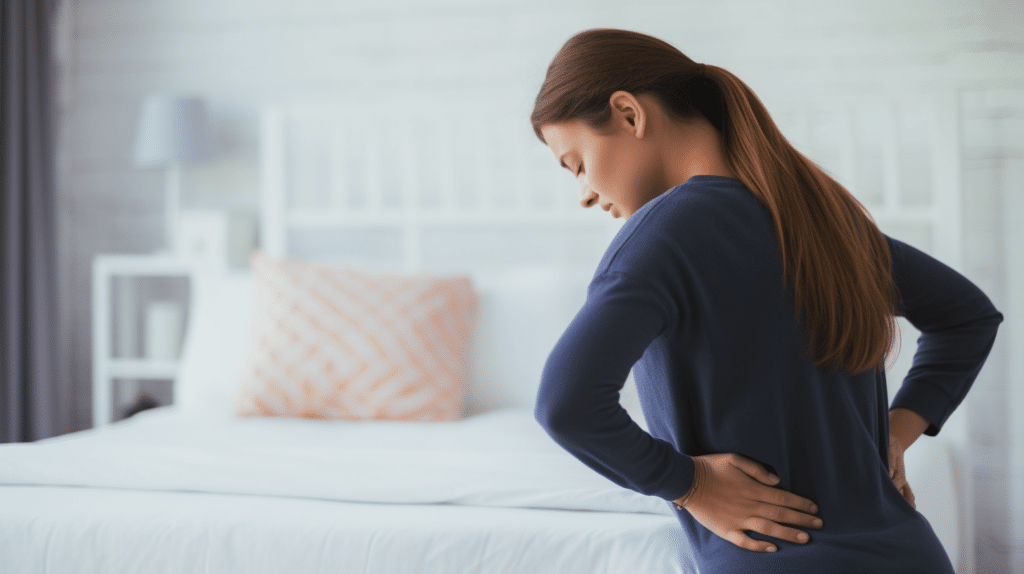
Sciatica is a form of back pain that radiates down through your lower back and one or both legs. It occurs when the sciatic nerve becomes compressed or irritated. This can be due to a spinal condition or injury, but it’s also common in pregnancy (see our roundup of pregnancy mattresses). You may also suffer from sciatic pain if you’re overweight, have poor posture or spend a lot of time sitting in front of a computer.
A new mattress won’t cure your sciatica, but it may help reduce your symptoms and help you sleep better. Here’s what you need to think about when shopping for a new mattress and some tips for getting a better night’s sleep despite bad sciatic pain.
Sleeping Positions For Sciatica
Let’s start by discussing the pros and cons of back sleeping, side sleeping, and stomach sleeping when it comes to sciatica. We’ll look at which sleeping position may be best for reducing pain and discomfort associated with sciatica.
Back Sleeping
When sleeping on your back, it’s important to ensure that spinal alignment is correct. Using a supportive mattress can help with this; memory foam, in particular, provides plenty of cushioning and helps keep the spine in its natural position.
Side Sleeping
For side sleepers, it’s important to adjust your body in such a way that the sciatic nerve is not aggravated. Placing a pillow between the knees or under the hips can help reduce any pressure on the lower back and reduce pain associated with sciatica.
If you’re worried about comfort while sleeping, look for a mattress specifically designed for side sleepers; these are often firmer than other mattresses, which helps provide additional support. With this combination of positioning and proper cushioning, you should be able to get more restful sleep without having to worry about exacerbating your sciatic nerve pain.
Factors To Consider When Shopping For A Mattress
Consider the following for best results:
Firmness
When considering a mattress for sciatica, firmness should be at the top of your list. It’s important to find one that isn’t too soft or too hard – it should provide adequate support while still being comfortable. The right level of firmness depends largely on body weight; those who are light-weight may prefer a softer mattress, whereas heavier individuals typically benefit from a firmer mattress.
Ultimately, finding a balance between comfort and support can help alleviate sciatica pain and ensure quality sleep. Therefore, take your time when deciding which mattress is best for you, as this could make all the difference in how well you rest each night.
Comfort
Once you’ve determined the right level of firmness, comfort should be the next factor to consider when shopping for a mattress for sciatica.
Everyone has different preferences in terms of how soft or hard they like their bed to feel – it’s important to find one that provides enough cushioning and support while still being comfortable. Look for mattresses with quality materials such as breathable fabrics or memory foam layers which can help reduce pressure points while providing contouring relief.
Support
Once you’ve found the right level of firmness and comfort, support should be your next consideration. Mattresses with pocketed coils are a great option for those looking for more support as they provide increased contouring and flexibility that can help reduce pressure points.
Additionally, a mattress should always have some kind of transitional layer between the coils and cushioning to ensure maximum stability and prevent sagging over time.
Types Of Mattresses For Sciatica
Let’s talk about the different types of mattresses for sciatica. There are several options, including innerspring, memory foam, latex, hybrid, and airbeds. We’ll explore each type to determine which one is best for those who suffer from sciatica pain.
Innerspring
If you’re looking for a mattress to help with sciatica, innerspring mattresses could be the right choice. They provide great support thanks to their coils, which are designed specifically to keep your spine properly aligned and take pressure off of your nerves. Innersprings also offer good ventilation, allowing air to flow freely and keeping you cool while you sleep.
Memory Foam
Memory foam is another type of mattress that can be beneficial for sciatica sufferers. This material conforms to your body, providing even weight distribution and superior motion isolation. Memory foam also has the added benefit of relieving pain since it contours around pressure points and helps reduce stress on joints. Plus, its soft texture prevents wakefulness caused by discomfort or movement from a partner during sleep.
Soft Vs Firm Mattress For Sciatica
When it comes to choosing the best mattress for sciatica, there is no one-size-fits-all solution. Different sleepers may have different needs and preferences when it comes to mattress type and firmness level. The important thing is to find a balance between support and comfort that matches your specific body shape, sleeping position, pain levels, and other individual factors.
For people with sciatic nerve pain, firmer mattresses will usually provide more support in the lumbar area than softer beds. Memory foam mattresses or all-foam mattresses are often recommended because they can conform closely to the sleeper’s body while providing ample support. But even within these categories of mattresses, there are various firmness options which should be considered before making a purchase decision.
In some cases where a soft mattress provides enough support for the lower back region, it could still be an acceptable choice for relieving sciatic nerve pain. However, finding this ideal combination of cushioning and stability requires careful consideration of your own unique needs as well as trying out several different types and firmness levels of mattresses before committing to buy one.
What To Look For In A Mattress
Sleeping on the wrong mattress can be like walking a tightrope – you want to get that perfect balance of comfort and support, but it’s often difficult to find. When choosing the best mattress for sciatica pain relief, careful consideration should be given in order to ensure both quality sleep and long-term back health benefits.
The type of mattress is key when selecting a bed for your specific needs. A hybrid mattress combines two or more materials such as memory foam and coils which offer great motion transfer reduction while providing extra cushioning and body contouring.
In addition, look out for mattresses with 10-year warranties which guarantee durability over time. Though they may cost more initially, these beds could save money in the long run by preventing future replacements due to premature wear and tear.
When considering different types of mattresses – such as an all-foam option or adjustable airbed – remember that your personal sleeping position plays an important role in determining optimal comfort levels. While side sleepers might benefit from added pressure point relief thanks to softer foams, stomach sleepers need slightly firmer surfaces for spinal alignment benefits.
Motion isolation and transfer are also aspects to take into account; if one partner moves around during their slumber then perhaps investing in a separate layer of memory foam comfort between them would help diminish any disturbance caused!
Benefits Of An Orthopedic Mattress
When it comes to choosing the best mattress for sciatica, an orthopedic mattress is a great option. It offers firmer support than traditional mattresses and may help reduce pain in those with sciatica, spinal stenosis, or bone spurs.
Additionally, many come with lifetime warranties that ensure you can make use of your investment for years to come.
Stomach sleepers should look for specialized orthopedic mattresses designed specifically for them as they have unique needs when it comes to motion transfer and preferred sleeping positions.
For individuals who prefer their lumbar region supported while they sleep, adjustable beds are also available so that they can customize their comfort level throughout the night.
Before purchasing any mattress, take some time to read customer reviews and ratings from previous buyers. This will give you a better idea of how well the product meets its claims and if it truly delivers on its promise of providing relief from sciatica pain.
Tips For Sleeping With Sciatica
Having discussed the benefits of an orthopedic mattress, it’s time to look into tips for sleeping with sciatica.
Sciatica pain can be one of the most debilitating forms of chronic pain and a good night’s sleep is essential in managing such discomfort. Finding the right mattress for sciatica can make all the difference in terms of comfort.
For people suffering from sciatica, firm mattresses are usually recommended as they provide better support to keep your spine in alignment while you sleep. However, some studies have suggested that medium-firmness mattresses may also be beneficial for sleepers with sciatica since it allows them to sink slightly into their bed – thus providing more cushioning without compromising on support.
An adjustable mattress might even be helpful if you’re looking for tailored back and neck support depending on how you sleep or where your pain comes from.
When shopping around for a mattress specifically designed to ease sciatica symptoms, reviews from customers who suffer from similar conditions could prove extremely useful since they know exactly what type of relief they need and which product works best for them. Additionally, consulting a doctor before settling on any particular mattress is always advised so that they can suggest specific pain relievers suitable to your body type and condition.
It’s worth trying different sleeping positions and pillow combinations to find something comfortable and keep your spine aligned. A good pre-bed routine will also help you relax and get in the right frame of mind for sleep.
If you’re struggling to get to sleep, these tips may help:
- Sleeping on your back with your knees raised can help alleviate pressure on your nerve roots. Play around with different pillow combinations until you find a position that suits you.
- If you’re a side sleeper, bend your top knee and prop it up using two or three pillows, so your hips are squared.
- A full-length body pillow (often marketed as pregnancy pillows) can help cocoon your body and prevent you from rolling over during the night. As the pillow extends between your legs, this means you don’t need to fiddle about with multiple pillows which may fall out of bed during the night.
- Don’t forget about your neck. Keeping proper spine alignment can help reduce lower back pain, so invest in a good pillow that supports your head in a neutral position.
- Research indicates that light stretching before bed can help relax tense muscles and relieve pressure on your sciatic nerve. Try these three stretches to help loosen and strengthen key muscle groups.
- A warm bath can help relax you and the muscles around your sciatic nerve. A hot water bottle can have a similar effect – just make sure it’s not hot enough to burn you.
- Get into a good sleep routine by eating healthily, avoiding blue screens before you go to bed and giving yourself time to relax and wind down if you’ve had a stressful day.
If you’re struggling to switch off at night, check out these tips for improving your sleep without resorting to drugs.
Alternative Solutions To a Mattress For Sciatica
If you’re looking for alternative products to help with sciatica pain, here are some options to consider:
- Lumbar Support Cushions: Lumbar support cushions are designed to provide support to the lower back, promoting proper spinal alignment and relieving pressure on the sciatic nerve. They can be used while sitting in chairs or even in the car. Look for cushions that are ergonomically designed and provide adequate support to the lower back.
- Heat and Cold Therapy: Applying heat or cold therapy to the affected area can help reduce inflammation and alleviate sciatic pain. Heating pads, hot water bottles, or warm baths can provide soothing heat, while cold packs or ice packs can help numb the area and reduce inflammation. Experiment with both heat and cold to find what works best for you.
- TENS Units: Transcutaneous Electrical Nerve Stimulation (TENS) units are small electronic devices that deliver low-voltage electrical currents to the affected area. They can help relieve sciatic pain by blocking pain signals and promoting the release of endorphins. TENS units are portable and can be used at home or on the go.
- Exercise Equipment: Certain exercise equipment can help stretch and strengthen the muscles surrounding the sciatic nerve, promoting pain relief and improving mobility. Some options include foam rollers, exercise balls, and resistance bands. These tools can be used to perform exercises that target the lower back, hips, and legs.
- Ergonomic Office Chair or Seat Cushion: If you spend long hours sitting at a desk, using an ergonomic office chair or seat cushion can provide better support for your lower back and help alleviate sciatica pain. Look for chairs or cushions that have adjustable lumbar support and promote proper posture.
Remember, it’s essential to consult with a healthcare professional, such as a doctor or physical therapist, to determine the underlying cause of your sciatica and receive personalized advice on the best products and treatment options for your specific situation.
Conclusion
The Layla Mattress is our top pick in the overall review as the best mattress for sciatica sufferers, particularly if you sleep with another person or tend to switch positions a lot during the night. It provides a good level of support for back, side and front sleepers, and excellent motion isolation at an affordable price.
At the budget end of the price scale, the Nectar is a great value option with a fantastic trial period. If you’re willing to splash out, then the New Purple is a favorite among back-pain sufferers.
Mattresses are a very personal choice. The right mattress for you will depend on your weight and build, preferred sleeping position and comfort level. While firm mattresses are generally thought to reduce sciatic pain, this doesn’t mean they’re the right choice for everyone. Fortunately, as most manufacturers offer at least a 3-month trial period, you can give your new mattress a proper test, and if it’s still not comfortable, send it back and try a different model until your slumber is perfect and pain-free.
